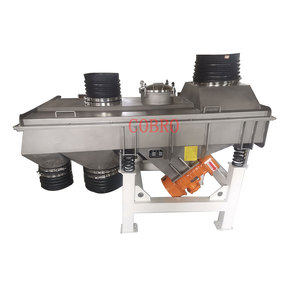(2746 products available)




























































































































































































Vibration classifier machines are used in various industries to separate different types of materials based on the sizes of particles. They function by using vibrating decks or plates to classify materials into desired categories. There are many types of vibration classifiers, which can be divided according to their shapes, the physical principle on which they work, and their intended use.
Other classification methods have been proposed in the literature to include the vibrating frequency and the particle size they work with. Frequencies that are usually used by classifiers to screen materials include low frequency, high frequency, and ultra-high frequency classifiers. Classifiers separating granular materials, including cement, coal, salt, sand, and sugar, are often referred to as fine, medium, or coarse classifiers.
Capacity:
The amount of material a vibration classifier can handle is called its capacity. This is how much stuff it can process in a certain amount of time - like tons or pounds per hour. Classifier machines with different capacities are available to meet the needs of small operations and larger ones.
Sizes:
The different sizes of particles a vibration classifier machine can separate are known as size ranges. Vibration classifiers can sift through fine powders, larger grains, and everything in between thanks to adjustable screen mesh sizes.
Power:
The amount of energy a vibration classifier consumes is its power usage, usually measured in kilowatts. Smaller classifiers may use around 1-2 kW, while bigger ones could use 5 kW or more due to handling larger volumes. The power requirement grows with the machine's size to effectively separate more material.
Design:
Vibration classifiers are made in different ways to suit various purposes. The most commonly used is the horizontal classifier machine. Other popular choices include linear vibration classifiers, inclined classifiers, and the circular classifier machine. Some have a slight slope for better flowing, while others are completely flat. The choice of design depends on what kind of materials need to be classified and separated by size in a given industrial setting.
For the optimum performance of a vibrating classifier machine, regular maintenance is a must. Users can, however, ensure the longevity of the classifier by taking these simple steps:
Food Industry
The food industry relies on classifier machines to enhance the quality of food products. One key application is nut and grain classification, where machines classify different types of nuts and grains based on size and remove any foreign contaminants. This ensures a safe and superior food supply. Another use is meat tenderizing, as classifier machines separate properly cut meat pieces for processing and packaging. Fruit and vegetable washing is also accomplished using classifier machines that remove unwanted debris, such as dirt and leaves, after washing.
Mining and Aggregates Industry
In the mining and aggregate industry, classifier machines play a vital role in separating minerals and rock materials. Using machine classifiers, operators can separate various minerals like sand, coal, gypsum, and lime based on particle size. The separated materials are collected for further processing or sale. The machines also classify rock fragments by size for subsequent crushing or screening. The classifiers improve the overall quality and efficiency of mineral and aggregate production.
Plastic and Recycling Industry
In the plastic and recycling industries, vibration classifiers help separate valuable raw materials from unwanted items. Their precision and efficiency reduce the need for manual labor, preventing injuries and increasing productivity. Vibration classifiers effectively sort plastic materials, such as PET, PVC, HDPE, and PP, based on type and color, ensuring the purity of the recycled output. They also remove contaminants like glass, metals, and textiles from the plastic waste, improving the quality of the input materials for recycling.
Consider the following factors of the food classifier machine when purchasing:
Using the above factors as a buying guide, it becomes easier to find a classifier machine that sorts intended materials and is functional and efficient.
Q1. How does a vibration classifier work?
A1. A vibrating classifier machine utilizes vibration and screen mesh to sort materials into different sizes. The feeding hopper drops the materials onto the screen, where they are bounded by the mesh. The fine materials fall through the meshes' holes onto the designated area, while the larger ones stay on top and get ejected.
Q2. What are the benefits of using a vibration classifier?
A2. One could expect many benefits from using a vibrating classifier for material separation. These include the benefits of a vibrating screen, such as high separation efficiency and capacity. Also, vibration classifiers have the flexibility of mesh size changing to optimize the separation process for the specific material being handled. They are also easy to maintain because screen replacement is a fast and straightforward process.
Q3. What classifiers are used in vibrations?
A3. Vibrating classifiers are designed to sort materials by size. Other classifiers include spiral air classifiers that use air currents to separate lighter particles and hydro-cyclone classifiers that utilize centrifugal forces to separate materials based on density. The rotary screens are mixed models that combine multiple separation methods to sort materials differently.
Q4. What materials can a vibration classifier screen separate?
A4. A vibrating classifier screen is suitable for separating granular materials, such as seeds, sand, sugar, salt, and plastic pellets. It works well with dry materials but is not ideal for separating sticky, damp, or oily substances.